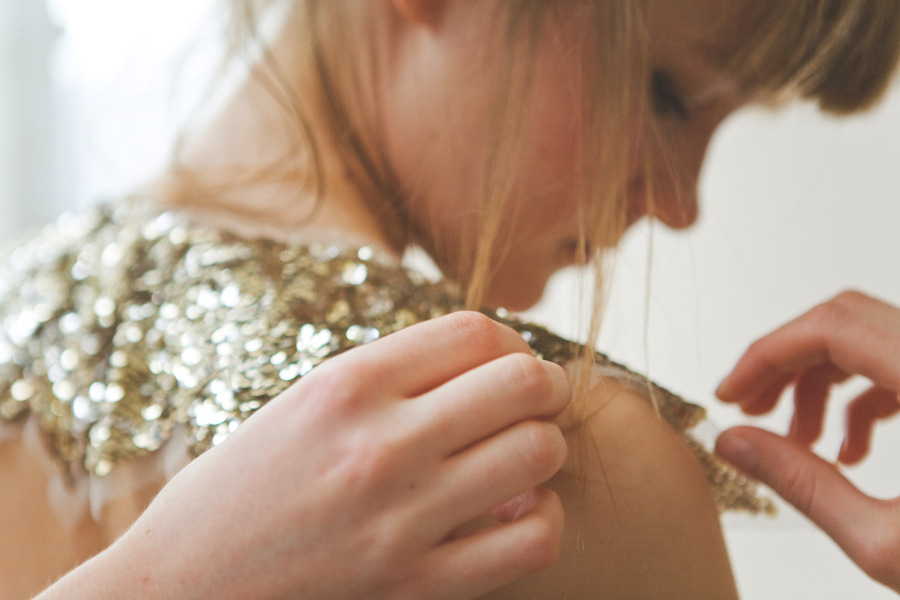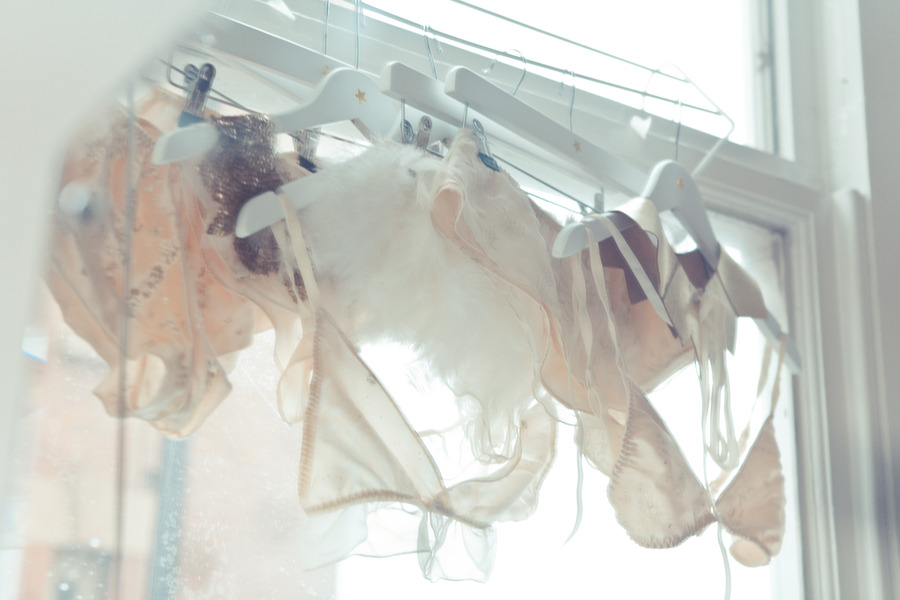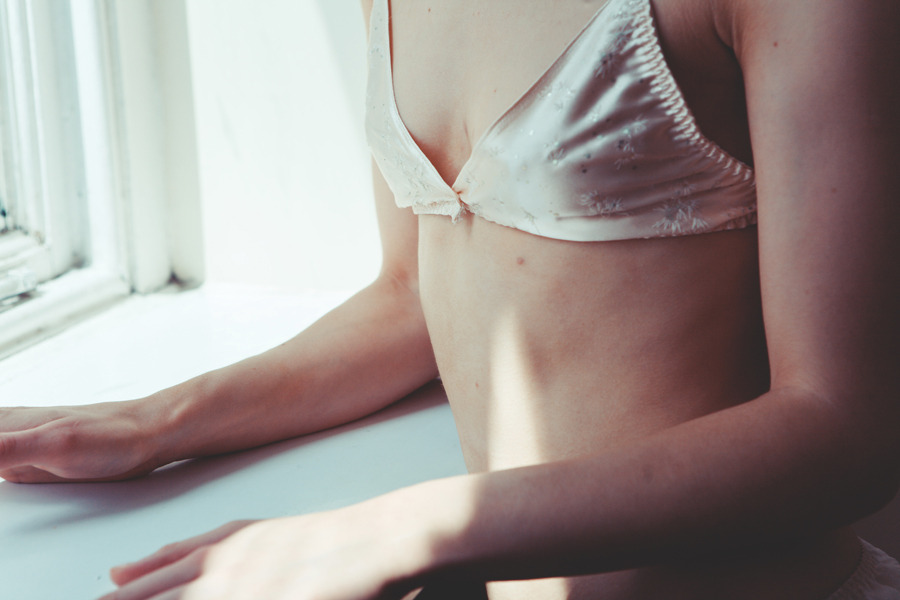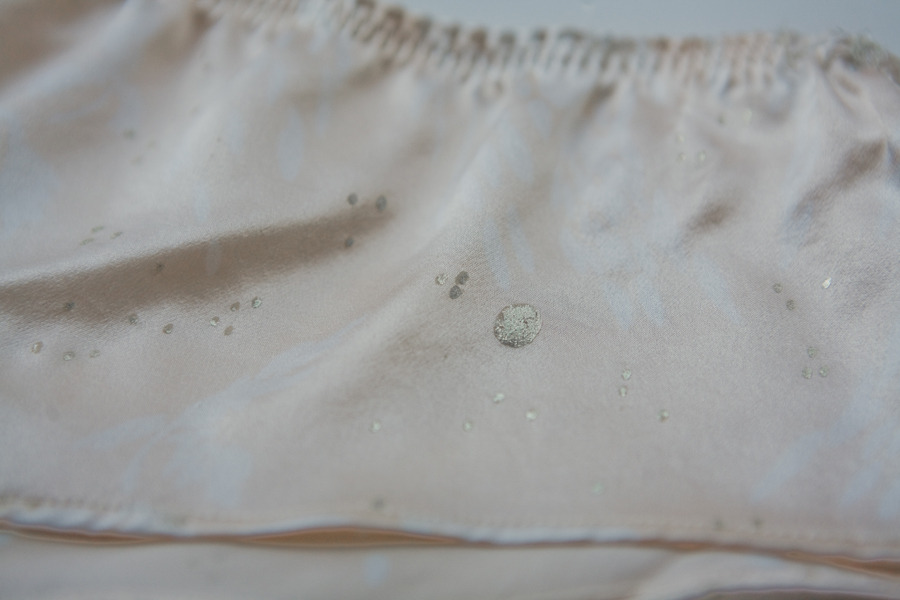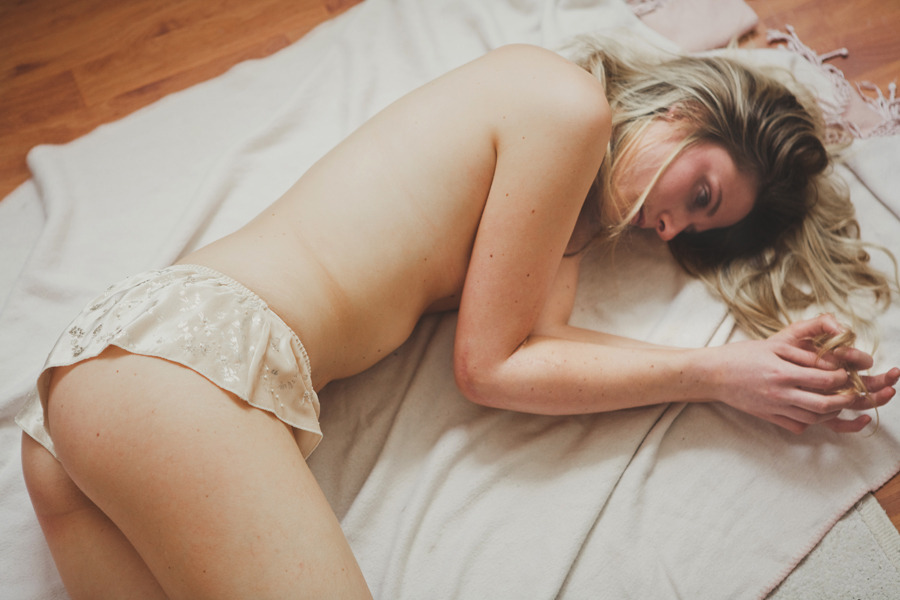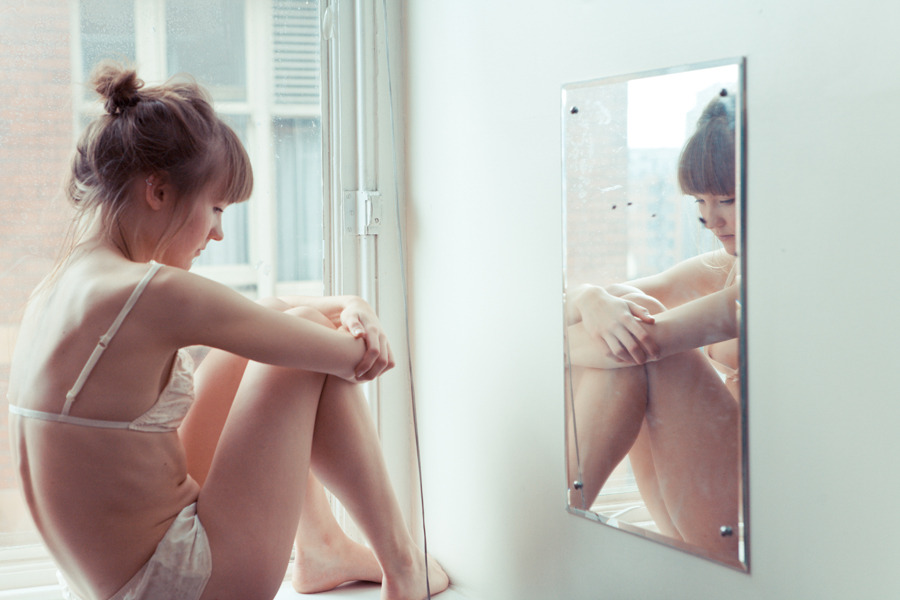If you follow me on Instagram, you might have seen me posting photos from Flimsymoon’s debut collection. I was introduced to Flimsyoon when designer/maker Freyia Lilian sent me a tweet way back in April. I found her aesthetic immediately fascinating and kept in touch with her over the months. In between several conversations about everyday frustrations, mental health and haircare, we decided to “interview” each other, so to speak, and talk about beauty, art and other lofty things that are broached only in bits and spurts in regular conversation. And in the midst of such contemplations, we also talked about Freyia’s lingerie collection, Kiss me under flimsymoon, its aesthetics, and how luxury and comfort go hand in hand for her.
Below is a transcript.
The Kickstarter to fund Flimsymoon’s first collection launches on 30 August with an evening of drinks and dancing at the Clerkenwell Gallery. For a free ticket to the launch party, just head over to the Eventbrite page!
R: So! Jumping right in, I was thinking of our last conversation earlier, and this one memory came back to me. For a huge portion of my life, when I still had a social circle of sorts, and still wanted social approval, I used to hate thin, pretty girls. Looking at girls (and women) who fit prevailing beauty standards would fill me with a deep seated envy because thinness and beauty was a form of social currency that I could never have. And then, right after I graduated from uni, I started hanging out with my closest friend now. She was thin and pretty and I’d disliked her greatly all throughout those three years, but once we became stoner buddies, everything sort of changed.
And it dawned upon me that thin, pretty girls are not the enemy, and if I had to pinpoint an enemy, it was all the beauty machine which exists to make women feel bad about our bodies – thin women, fat women, in between women, all of us. When you told me last night about how you wouldn’t dare wear things I have on my blog, the first thing I thought was, ‘but she is so beautiful! Why would she have body issues?’ And then I remembered that it doesn’t really matter what you look like, because the beauty industry will find a way to make you feel bad.
F: Yes I agree. ‘Beauty’, as projected by the fashion/beauty industries, is kinda narrow and unimaginative, being as it is, a word which only exists because of, and is created out a primordial soup of visual references and connotations taken from all areas of culture, history and thought. Showcasing these very rich and diverse aesthetics by utilising the beauty of a very narrow demographic of women seems like such an easy way out. And I think it naturally helps kick in a horrible survival instinct powered by the green eyed monster!
It’s funny because I can completely relate to what you went through in terms of comparing yourself to other women. You are true in saying that it is a universal problem, and no matter how close to the ideal you are, it doesn’t mean you will feel any more empowered or beautiful. My auntie for example, who is whippet thin naturally and a complete babe, suffered from anorexia as a teen and made herself very ill. When I look at you, though, it excites me to think that brands have asked you to do shoots for them, especially lingerie! It’s high time the fashion industry stepped out of the box, and stopped labelling. Fuck ‘plus size models’ or whatever. Models are models.
R: Beauty is a strange thing. It’s one of the least quantifiable concepts, yet we tend to treat it as a certain rigid set of parameters. More than anything, it’s odd and erratic, existing in that liminal space which could turn striking or ugly, at will. I recall a short story from a collection called The Summer House, Later, where one of the characters muses on the nature of beauty. And they reach the conclusion that beauty is odd and ugly – look at Jackie O- that quote went, I think – she’s practically a hammerhead. And that’s exactly it. Beauty is asymmetrical, it’s unpredictable and eerie. Beauty haunts you, glamour doesn’t. I want to be startled by beauty, I want it to take me unawares, I don’t want it to cocoon me in a numbing homogeneity. Because if everyone looked the same, how could beauty exist?
F: I agree! I have this utopian idea of what I want as the future of visual representation of beauty. I want to see all those gorgeous archetypes of nudes in art, all those types of female beauty, all the facets of it to be represented.
When I was working on shooting the collection, I spent a lot of time thinking about who should model. I wanted to approach girls who I thought were beautiful, rather than going through an agency. It was really important that the images be comfortable and intimate, and not shiny shiny. I reached out to two girls in my social circles (one of whom has become one of my best friends) and while they both have conventional builds for models, I was more drawn to their faces and demeanours. Another girl I approached was less conventional, but she ended up declining.
R: I really, really love the shoot for your collection (and ofcourse, the collection itself!) Your aesthetic is so wonderful, and it shines through even in something as simple as your Instagram photos. You seem to find beauty in places people would normally overlook – and that’s one of the greatest gifts. It’s such a ~ sensitive artist~ cliche, but unthinking utilitarianism just feels like sensory deprivation to me.
F: I’m such a sensitive artist too, and have had a history of anxiety. One big bout of it was at the beginning of my third year of uni when I was so overwhelmed with ideas from the delicious theory I’d been reading that summer, and all the possibilities of how I could translate that visually entity. I feel a lot. And sometimes that can be detrimental as well, bouts of extreme lows and anxiety for example, but overall, the positives of being a sensitive soul outweigh the negatives, I think! I’m proud of my empathy and ability to feel, and to project those feelings in art.
R: I’d love to know more about the theory you were reading! The reason I couldn’t stick it with academics is that theory just didn’t agree with me. I found so very few scholars whose writing felt like they were trying to communicate something meaningful, rather than endlessly circle jerking in futile wordplay. Which might seem strange considering my MA dissertation used Bhabha extensively! All the while I was writing it though, I was cursing the man for having great ideas but presenting them in the most obtuse manner argh! As someone who loves words for their own sake, my greatest stumbling block with theory is how badly written a lot of it is.
F: Theory! Yes I totally agree. One of my favourite ideas regarding the erotic comes from Georges Bataille’s introduction of his book ‘Eroticism’. But even though the theories are fascinating, I didn’t make it all the way through because of his PRETENTIOUS BLABBER! I swear philosophers write in code. Not that I’m an expert or anything, but from my dabblings in the subject, I really believe most of them could describe their ideas in a more poetic, beautiful and accessible manner if they only tried! Or maybe they do it on purpose to be elitist pricks. If Bataille were alive today, he’d totally be a hipster swaggering around East London (if he wasn’t French, that is!)
I love words too and really enjoy critical/ analytical writing. But art school taught me a really good lesson that I think some theorists need to take on board! And that is to be clear, coherent and accessible when describing a complex idea.
And that’s one reason I love folklore and fairy tales. They all discuss complex concepts using accessible signs and symbols. You can read them purely aesthetically as a montage of alluringly beautiful and bizarre images – admire them superficially. But you can also delve deeper and get lost in their content (fangirling right now!)
R: Haha, that image of Bataille as an east London hipster!
I’ve never done a formal study of folklore, but I have fond memories of reading and being read stuff like ‘Thakumar Jhuli’ and ‘Khirer Putul’ as a child. Funnily enough, most of what we know of Bangla folklore comes from the zealous burst of collecting oral tales in the Victorian era, which was not only inspired the similar burst in Romantic-era Britain, it began as an Orientalist project of knowledge gathering by the then Governor General. And one of the first books I ever remember is a Soviet hardback edition of Andrew Lang’s folktales that used to sit quite self importantly on my parents’ bookshelf. So I guess everything is connected, really!
I have an absolutely mandatory question for you now, because it’s something I get asked every time there’s an interview. And that’s…inspiration. I want to know what your inspirations are! You mentioned a while ago how making lingerie that fits someone’s natural shape instead of moulding it to conform to certain normalizing standards is very important to you. How did you form that ethos, what was your inspiration/motivation? I rejected shapewear a long time ago, and last year I did away with conventional bras, and I feel so much better after that!
F: I do own a few underwired contraptions, but I only really wear them under closer fitting clothes or tees, or if the silhouette calls. I do feel kinda uncomfy all day though. I’d much rather wear a soft cloth something, like a bandeau or triangle bra, forget about my boobs, and not feel all trussed up.
I was influenced a lot by dancewear, and oddly enough childrenswear when developing an aesthetic, because of the simplicity and utility they combine with a very aesthetically driven finish – often anchored in storytelling and evocative imagery.
I am making luxury products. They are not intended to be ‘super supportive’ when running for the bus, or going about your everyday life. My pieces are intended to be special treats! The female body is often so trussed up and squeezed into this and that, contorted here, nipped in here, pushed up there. Flimsymoon pieces intend to be worn by women, not the other way round. I’m all about comfort and the feeling of wearing something soft and adoring.
R: Yeah, there’s such a prolonged history of women’s bodies being strapped in, and harnessed and confined, right from the Renaissance in the Western World alone, and I find that the current insistence on the ‘perfect silhouette’ with shapewear and underwired bras plays into that tradition. My fashion philosophy has always been centered around the concept of all bodies being good bodies, and that includes rejecting the notion that there are certain items of clothing I can’t wear because of my size. Refusing to painfully contain my boobs with pointy underwires is part of that now. I don’t see why anyone needs to be offended by my natural silhouette.
It’s kind of strange actually talking about stuff on my blog, you know! Even though this is ground I’ve covered before, here and elsewhere. It’s probably to do with how much I hate airing opinions publicly and being paid any kind of attention. Attention is something that’s always made me feel uncomfortable, and remembering that kind of makes me think that I should be doing something else altogether! I should just get my back fixed and build that homestead my partner and I have been planning to. Now that sounds like a plan.
F: Oh, don’t give up on humanity just yet! What’s that thing Zooey Deschanel said about being constantly shushed for being openly vulnerable/sensitive to things but instead of seeing it as a negative, owning it as a strength? I’ve been reading, and thinking a lot recently about vulnerability and femalehood, and owning your femme. To me, it’s like vulnerability creates empathy and that can only make things better. It’s one of the amazing things about people, I think.
❤ ❤ ❤ ❤ ❤ ❤
F L I M S Y M O O N
Facebook // Twitter // Instagram
Lookbook Credits
Photographed by India Hobson // Styled by Freyia Lilian // Makeup by Makeda Carayol // Models Annabel Collins and Hannah Shkandrij
